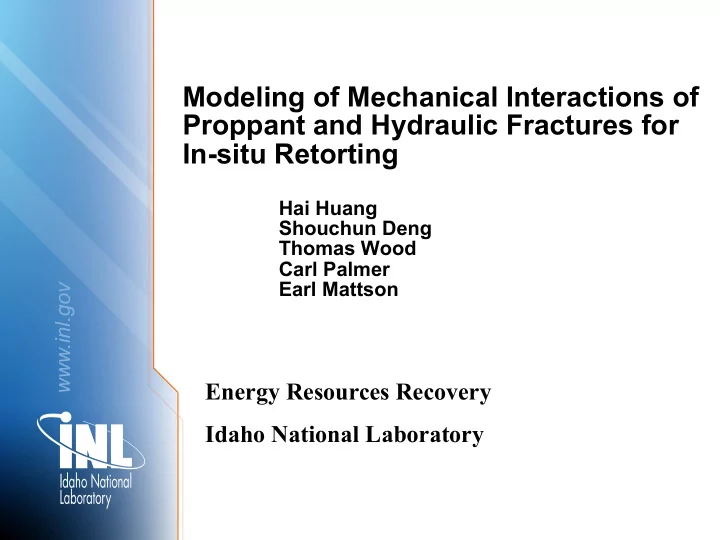

Modeling of Mechanical Interactions of Proppant and Hydraulic Fractures for In-situ Retorting Hai Huang Shouchun Deng Thomas Wood Carl Palmer www.inl.gov Earl Mattson Energy Resources Recovery Idaho National Laboratory
Outline • Introduction and background • Modeling approach: discrete element model • Review of mechanical properties of oil shale as function of grade and temperature • Model calibration • Results and discussion
Background • Various in situ approaches require hydraulic fracturing & proppant filling – To facilitate flow of hydrocarbon fluids – Some approaches require connectivity of proppants, i.e., Electrofrac (ExxonMobil) • Need better understanding of mechanical interactions between shale and proppants under in situ conditions – Stress focusing – Proppant embedment – Deformation of fracture walls – Changes of fracture aperture as function of stress and temperature
Objectives • Quantify proppant embedment as function of: – Proppant size – Modulus of shale – Confining stress – Temperature – Elastic vs plastic deformation • Evaluate performance of hydraulic fracture: – Stress-dependence of fracture aperture – Evolving porosity in propped fracture – From evolving aperture/porosity to predict permeability of propped fracture: Carman-Kozeny, for example
Modeling Approach: Discrete Element Model • Particles interact through bond. • Bond can be broken if shear stress and/or tensile stress in bond exceeds threshold (i. e., critical tensile/shear stress). • Repulsive & fraction forces between grains in contact after the bond is broken σ • Plasticity was triggered if either grain or bond compressive deformation exceeds elastic limit: a simple ideal plasticity model • The particles will be marked for undergoing plastic deformation. ε ε y
Mechanical Properties of Oil Shale at High Temperatures Source: Eseme et al., 2007, Oil Shale
Mechanical Properties of Oil Shale at High Temperatures Source: Eseme et al., 2007, Oil Shale
DEM Model Calibration For Oil Shale at High Temperatures 0.015 Critical strain for plasticity 0.004
DEM Model Calibration For Oil Shale at High Temperatures "
Conceptual Model Model domain Hydraulic fracture filled with proppants Representative of physics and in situ condition Periodic BC Periodic BC Two types of proppant used: 20/40 and 40/70 (US mesh sizes)
Simulation Results: 150°C, 20/40 proppant 1470 psi (10.1MPa) 5390 psi (37.2MPa) 6860 psi (47.3MPa) Linear elastic Right before peak stress After peak stress
150°C, 20/40 proppant-development of plastic zone 6860 psi (47.3MPa) 1470 psi (10.1MPa) 5390 psi (37.2MPa)
Comparison at 150°C between 20/40 and 40/70 1470 psi (10.1MPa) 5390 psi (37.2MPa) 6860 psi (47.3MPa)
Comparison at 150°C between 20/40 and 40/70 20/40 40/70 1470 psi (10.1MPa) 5390 psi (37.2MPa) 6860 psi (47.3MPa)
Simulation Results: 300°C 20/40 4640psi (32MPa) 870psi (6MPa) 2900psi (20MPa) 4350psi (30MPa) 40/70
Fracture Aperture Reductions 150C 300C • Larger proppant lead to larger aperture reduction
Discussions • DEM model is appropriate approach for modeling proppant-shale interactions in hydraulic fractures • The credibility of model predictions, i.e. , stress focusing, proppant embedment and aperture reduction, is determined by the availability of mechanical test data. • A great need to fully characterize mechanical behaviors of oil shale as function of temperature, grade and conversion degree. • Need to consider effect of fluid pressure inside the aperture: coupling DEM with flow model
Recommend
More recommend